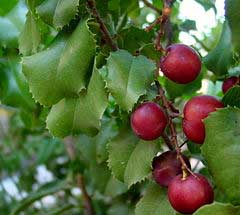It was about 90 years ago the evergreen Catalina cherry (Prunus ilicifolia ssp. lyonii) was first introduced as a garden shrub or tree. Since then it has become one of the most useful of all the California native plants. Climate, soil, exposure and water have a bearing on the size and shape of the shrub, but generally the crown is at first pointed and later more compact. Under ideal conditions it may reach 50 feet, but where there are cultural drawbacks, it may remain a slow-growing shrub.
The leaves on individual specimens often vary in shape and size, but they are generally smooth edged and leathery and shaped like plum tree leaves from 2 to 5 inches long. They are a dark shining green on top and a yellow-green beneath. Small cream-colored and sweet-scented flowers sometimes last through June and are carried in racemes from 2 to 6 inches long that hang near the ends of the boughs. When a Catalina cherry is hung with glistening edible fruit – dark red at first and later black – it is just as attractive as when it is in bloom.

Catalina cherry is not native to the mainland but to some of the coastal islands, where it is seen in the height of its development. It is well adapted to gardens of the mainland, however, where cold is not extreme.
It can be used in many ways: as a specimen tree or shrub, as a trimmed hedge. or pruned to serve as a backdrop for boulders, birdbath, a garden seat or for low plants. It grows best in full sun but will tolerate some shade. It needs good drainage and deep loamy soil. It is sometimes espaliered against a fence or wall where the air is dry. In inland gardens it will need summer watering, particularly during the long drought. A newly placed plant should have frequent waterings during its first three years. Given ideal conditions it is a rapid grower and may grow as much as 15 feet in less than three years. In areas where smog is thick the foliage is likely to mildew, especially in the shade. for in its native habitat, though accustomed to some fog, it has a free flow of pure sea air.
